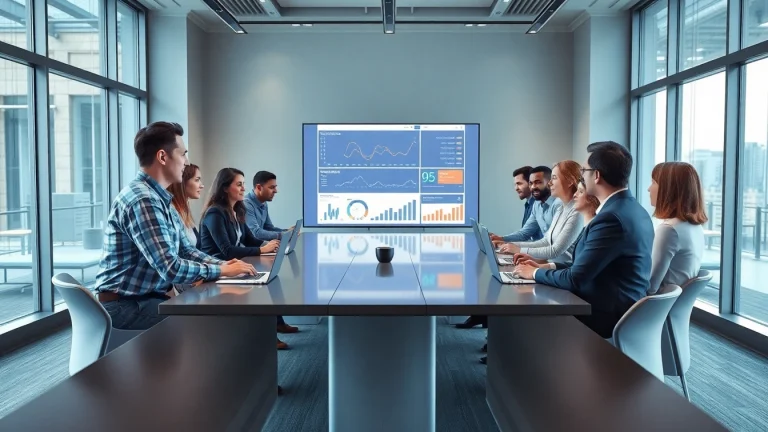
Strategies to Engage B2B Buyers: Insights and Best Practices
Understanding the B2B Buyer Journey
In the complex ecosystem of business-to-business (B2B) sales, understanding the B2B buyer journey is crucial for developing effective marketing strategies. B2B buyers have distinct needs and behaviors that set them apart from individual consumers. This article explores the intricacies of the B2B buyer journey, offers insights into engaging these buyers effectively, and provides real-world examples of successful strategies.
Defining the Stages of the Buyer Journey
The B2B buyer journey is typically broken down into three primary stages: awareness, consideration, and decision. Each stage plays a pivotal role in how businesses engage with potential buyers.
Awareness Stage
At the awareness stage, buyers recognize a problem or a need within their organization. They begin searching for information, exploring potential solutions that could address their challenges. This stage is crucial for marketers, who must produce informative content that captures attention and fosters brand awareness.
Consideration Stage
Once the need is acknowledged, buyers move to the consideration stage, where they actively evaluate various options. They may compare products, assess vendor credibility, and seek testimonials or reviews. At this point, providing thorough case studies, white papers, and product demos can influence their decision-making process.
Decision Stage
Finally, in the decision stage, the buyer is ready to make a purchase. They will consider pricing, terms, and the overall value of the offerings. This stage requires persuasive content that reassures the buyer of their choice, such as FAQs, customer success stories, and detailed product specifications.
Identifying Key Decision-Makers
Understanding who influences the B2B buyer’s journey is critical. Multiple stakeholders—often referred to as the buying committee—may be involved, including:
- The Economic Buyer: Usually the one who has the final say regarding budgets and expenditures.
- The User Buyer: The individuals who will ultimately use the product or service and can provide invaluable insights into practical requirements.
- The Technical Buyer: Responsible for assessing the technical compatibility of solutions and ensuring they meet organizational requirements.
Mapping Buyer Pain Points
Being aware of potential pain points can help businesses tailor their marketing efforts effectively. Common challenges faced by B2B buyers include:
- Budget Constraints: Many organizations work with strict budgets, and any solution must demonstrate ROI.
- Complex Needs: B2B buyers often face unique, complex requirements that standard offerings may not meet.
- Time Pressures: Long buying cycles can deter engagement, so timely communication and response are crucial.
Effective Strategies for Reaching B2B Buyers
Once organizations understand the intricacies of the B2B buyer journey, the next step is to adopt effective strategies for engaging these buyers. Below are highly effective tactics that resonate with B2B buyers.
Content Marketing Tactics that Work
Content marketing is a cornerstone of B2B strategies. High-quality, informative content can nurture leads and establish credibility. Here are some tactics:
- Blog Posts: Regularly publishing articles that address industry challenges will attract potential buyers and establish authority.
- Infographics: Visual content can simplify complex information and engage busy professionals effectively.
- Webinars: Offering live or recorded webinars can position your company as a thought leader while providing value to potential clients.
Utilizing Social Media for Engagement
Social media platforms can significantly enhance B2B engagement. LinkedIn, in particular, is vital for reaching business audiences. Companies should regularly share industry insights, engage in discussions, and join relevant groups.
Leveraging Email Campaigns to Nurture Leads
Email marketing remains one of the most effective strategies for B2B engagement. Personalizing email messages and segmenting lists based on buyer personas ensures that your content reaches the right audience at the right time. This could involve:
- Providing valuable content such as eBooks and guides.
- Offering exclusive invites to events or webinars.
- Regular follow-ups to keep your brand top of mind.
Challenges B2B Buyers Face Today
Despite advancements in technology and practices, B2B buyers face several challenges in the purchasing process. Understanding these challenges can help tailor solutions more effectively.
Navigating Complex Procurement Processes
The procurement process in B2B businesses can be tedious, often involving multiple stakeholders and lengthy evaluations. Buyers must navigate various approval layers, making it essential for vendors to provide clear and straightforward solutions to facilitate decision-making.
Addressing Quality and Reliability Concerns
With many options available, buyers often grapple with concerns over quality and reliability. Establishing a robust track record through case studies, testimonials, and industry certifications can mitigate these fears and build trust.
Staying Updated with Market Trends
In an ever-evolving business landscape, staying abreast of market trends is crucial for B2B buyers. They need timely and relevant information to remain competitive, making it important for companies to share industry insights regularly.
Measuring Success in B2B Buyer Engagement
Continual evaluation of engagement strategies is vital for achieving long-term success. Key performance indicators (KPIs) present an opportunity to measure effectiveness and refine approaches.
Key Performance Indicators to Monitor
Some critical KPIs to consider include:
- Lead Generation Rates: Measure the number of leads generated versus the total marketing efforts.
- Conversion Rates: Assess how many leads turn into paying customers to gauge effectiveness.
- Engagement Metrics: Track social shares, clicks, and comments to understand audience interaction with your content.
Using Analytics to Adapt Strategies
Analytics tools can provide insight into what content resonates with your audience. Using this data allows for adapting strategies accordingly, ensuring that you meet the evolving needs of your audience.
Feedback Loops for Continuous Improvement
Establishing feedback loops encourages clients to share experiences and insights, which can be invaluable for refining products and marketing strategies. Ask for input post-sale and implement changes based on this feedback to enhance buyer satisfaction.
Case Studies: Success Stories with B2B Buyers
Examining success stories provides practical examples of how to engage B2B buyers effectively. Here we discuss cases that exemplify innovative marketing strategies and provide valuable lessons.
Innovative Approaches in Various Industries
For instance, a leading software company successfully revamped its approach by leveraging customer data to personalize marketing campaigns. By understanding their clients’ industries and needs, they created tailored messaging that led to a significant increase in engagement and sales.
Lessons Learned from Failed Campaigns
Conversely, failed campaigns offer opportunities for growth as well. A manufacturing firm launched a product without fully understanding their target audience’s pain points, resulting in poor sales. Analyzing what went wrong allowed them to pivot and reassess their approach, ultimately leading to a successful relaunch based on buyer feedback.
Integrating Feedback for Future Success
Finally, successful companies continuously integrate buyer feedback into their processes. By valuing and responding to client insights, businesses can ensure their offerings remain relevant and competitive.


